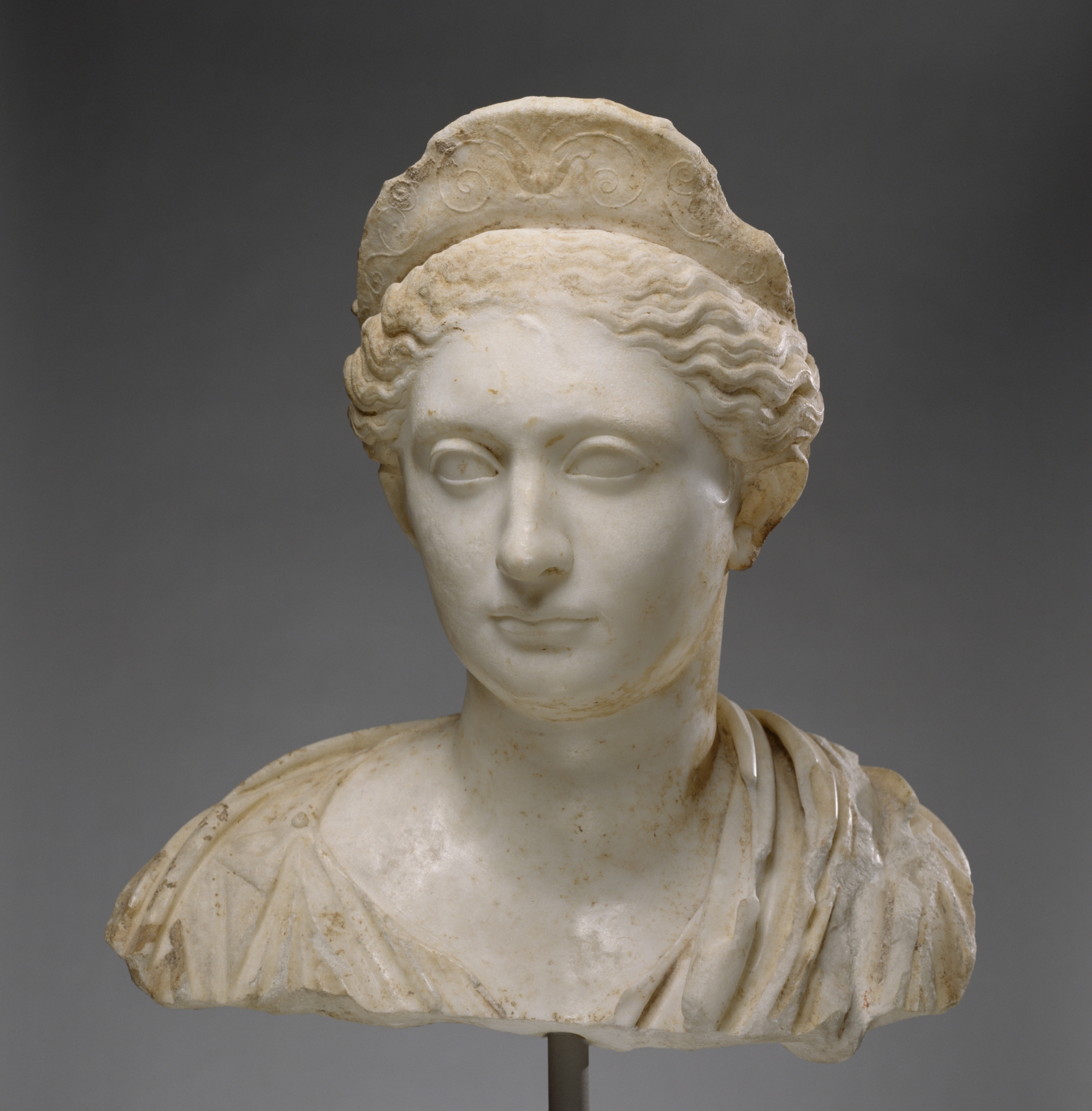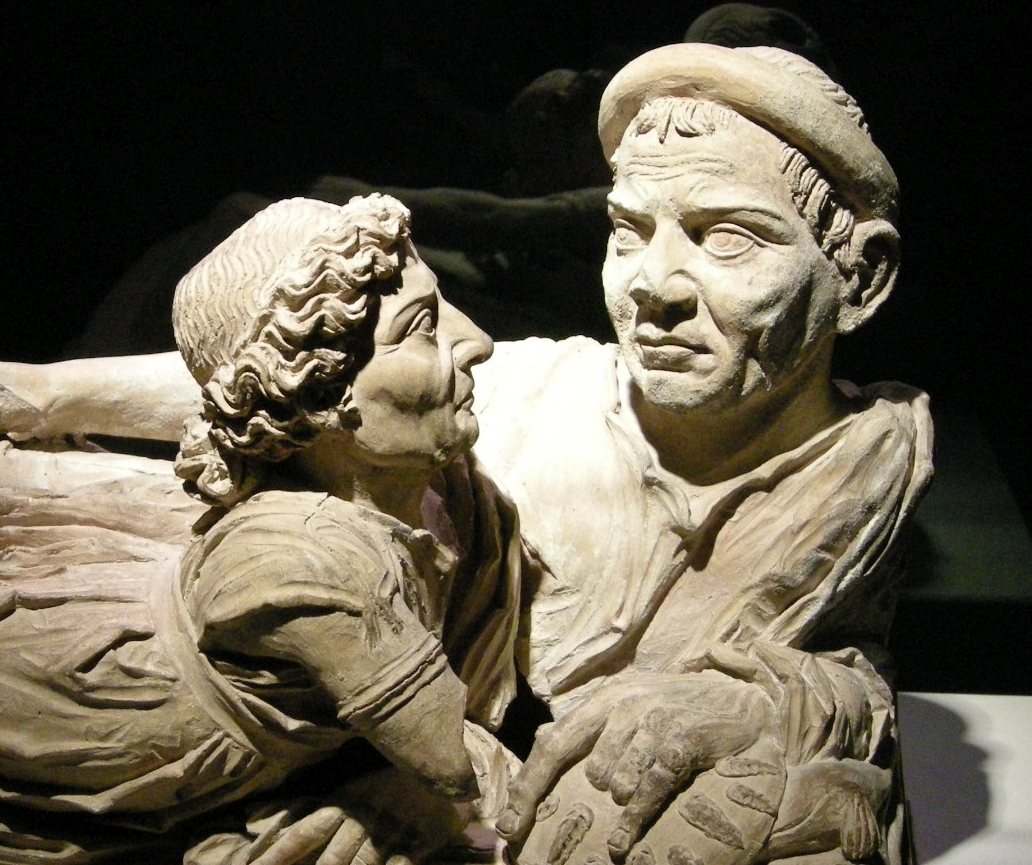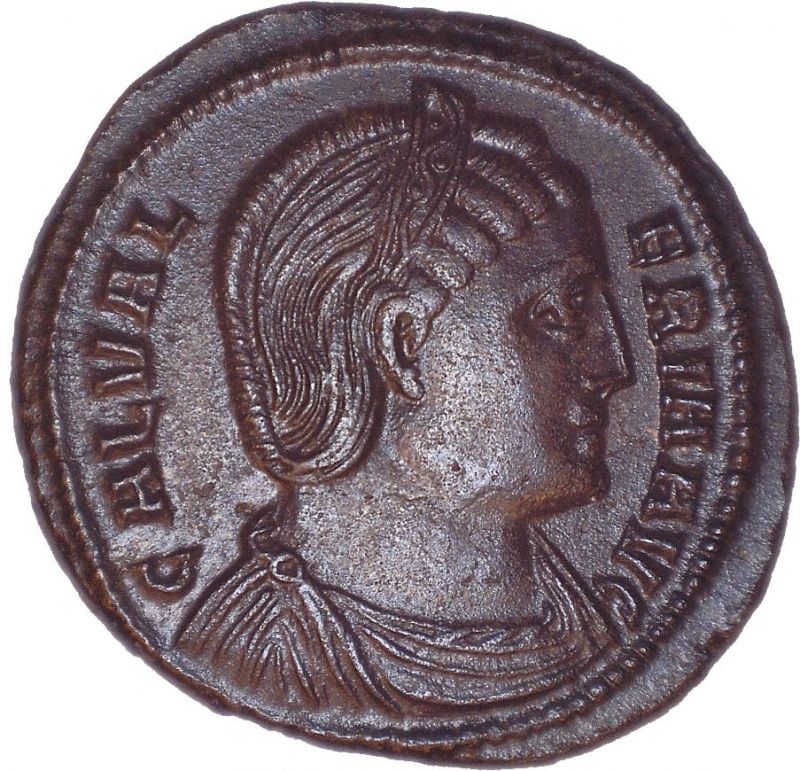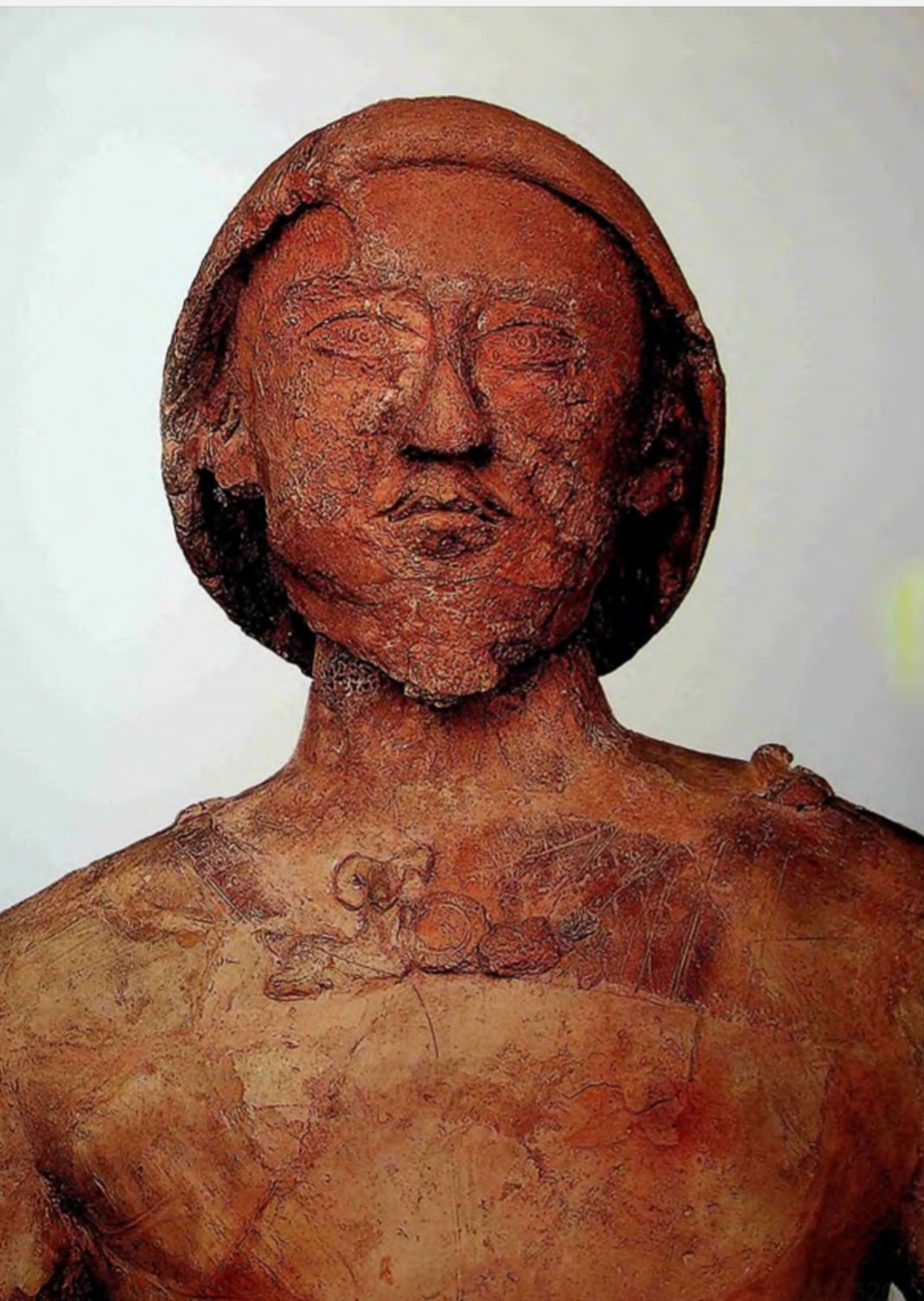




- Oxford, last statues in discussion >> http://laststatues.classics.ox.ac.uk/database/detail.php?record=LSA-574
Over life-size head, worked separately. H: 33.8, H (chin to crown) 17.2 cm. Fine-grained white marble.
The head is preserved with its neck and the beginning of the bare right shoulder; the left shoulder is not included in this separately worked element. It was probably inserted into a draped statue. There are holes (11) in the flat upper border of the crown for the insertion of some element. The nose and a portion of the hair below the right ear are restoration. The left upper edge of the diadem is chipped.
The top of the head has been shaped and smoothed but given no representational detail; the braid behind the crown is also devoid of detail. The hair around the brow is worked with a flat chisel. The pupils of the eyes are deeply drilled U-shapes. The irises are large, engraved circles.
PROVENANCE
It was purchased from the Quirici collection in Modena which was probably acquired in Rome.
DESCRIPTION (Subject)
The woman wears a jeweled crown which identifies her as an empress. The crown consists of a lower band of projecting circular stones or pearls; above that are 15 square bevels which contain square decoration; in the upper edge of the band with the square bevels are holes for the insertion of further decoration; and in the center an oval jewel, larger than the flanking stones, is surmounted by a large rectangular bevel, it larger than the flanking bevels. She also wears pendant, possibly pearl, earrings.
The hair is parted in the center and pulled to both sides, covering the ears. At the back the hair is divided into two sections which begin each behind an ear and cross over each other above the center of the nape. They are then pulled around the head and form a band behind the crown.
The face is essentially oval, though it is slightly wider across the cheekbones. The eyes are large, and the skin beneath them is carefully modelled to suggest age. The mouth is short from side to side and has marked corners. The chin, whose upper border is defined by a curving line below the mouth, is deep and projecting.
DATE AND HONORAND
Attempts to date the portrait or identify the honorand can use three factors which however provide only a general date in the fourth century.
1) The type of pearl-edged crown with rectangular stones and a central decoration provides a terminus post quem of c. 330 since it first appears regularly on coin portraits of the sons of Constantine. In the round a similar crown is preserved on both LSA-582 and LSA-578 , which are generally identified as Valentinian or Valens. The same sort of crown appears also on Theodosian portraits; see LSA-163 and LSA-337—though in these two extant examples of that period there are no rectangular bevels between the pearls.
2) The hairstyle is a fashion that has a slightly earlier terminus ante quem than the crown. It appears on coin images of the women of Constantine, and most particularly on that of his half-sister Constantia (married to Licinius). Delbrueck used the numismatic evidence to argue that the hairstyle, two encircling braids rather than a central vertical braid up the back, should date the head between 330 and 360. This hairstyle is distinctly out of favor in the coin portraits of the women of the Theodosian court.
3) Stylistically the head is close to LSA-337; they share a similar facial structure, proportions of eyes and mouth within the face, finely engraved hair separated from the brow, and softly modelled skin below the eyes and around the mouth. In fact on stylistic grounds, Schade argues for a Theodosian date.
J. Lenaghan
Main Reference
Schade, K., Frauen in der Spätantike–Status und Repräsentation, Mainz 2003, 187-8, no. I 27, pl. 40.2-3
Delbrueck, R., Spätantike Kaiserporträts. Von Constantinus Magnus bis zum Ende des Westreichs , Leipzig 1933, 169-71, pls. 69-70
Discussion References
L’Orange, H. P., Das spätantike Herrscherbild von Diokletian bis zu den Konstantin-Söhnen, 284-361 n. Chr. Das Römische Herrscherbild. III. Abteilung ; Bd. 4 , Berlin 1984, 149
Stutzinger, D. (ed.), Spätantike und frühes Christentum. Ausstellung im Liebieghaus, Museum alter Plastik, Frankfurt am Main. 16. Dezember bis 11. März 1984, Frankfurt a.M. (1983), no. 54
von Heintze, H. ‘Ein spätantikes Mädchenportät in Bonn. Zur stilitischen Entwicklung des Frauenbildnisses im 4. und 5. Jahrhundert’, Jahrbuch für Antike und Christentum 14, Münster 1971, 76, no. IV 3 (mid fourth century)
___________________________________________________________
2. CORONAE, STEPHANAI E DIADEMATA By FEDERICA GROSSI pp 325 https://core.ac.uk/display/161407923
Definizione: head of Costanza, wife of Licinius and half-sister of Constantine.
Collocazione: Como, Museo Archeologico “Paolo Giovio”, n. inv. E 2951.
Provenienza: ignota. Già nella collezione
Archinti e poi Quirici di Monza, fu acquistata sul mercato antiquario a Milano nel 1919.
Materiale: marmo lunense.
Misure: h. complessiva 0,338 m
Description: woman’s head alternately recognized as Costanza or as Licinia Eudoxia. The face is a beautiful oval with shapes rather rigid and square: the eyes are a lot large, characterized by iris and pupils underlined by thin eyelids, while the arches eyebrows are arched and give the woman a severe and authoritative expression; there mouth is small but with full lips and chin prominent, underlined by a dimple in half. The hair is parted by a parting central not very marked and carried almost like a helmet on the head, to be then folded and stopped on the back, as seen at
ears: the back of the portrait and the cap are not finished.
Dating: due to uncertainty of identification, the dating fluctuated between the Constantinian age in the first half of the fourth century AD or the subsequent one, attributable to the second half of same.
Type of ornament: Type IV, mixed tiara. Constance wears a double-sided mixed-type diadem, that one lower composed of a string of pearls with a circular medallion in the middle, at the forehead, e the upper one, on the other hand, is made up of quadrangular plates inside which they seem to be set precious gems. Along the entire extension of the diadem 13 holes are visible, in which it is thought that some were fixed metallic elements, perhaps some rays.
Bibliografia: CALZA 1972, pp. 270-271, n. 183; tav. XCV, 338-339; NOBILE DE AGOSTINI 2006, p. 58, n. 10;
LAMBRUGO 2013, p. 267; http://www.romehistory.co.uk/empress/Resources/cliciniaeudoxia4.jpeg (ultima visita
03/03/2017)
__________________________________________________________
3. Licinia Eudoxia imperatrice d’Occidente by Margherita Guarducci
https://www.jstor.org/stable/44515520?read-now=1&seq=1#metadata_info_tab_contents



4. Spätantike Kaiserporträts: Von Constantinus Magnus bis zum Ende des Westreichs
5. OPERE D’ARTE BIZANTINA IN LOMBARDIA
LINEAMENTI PER UN CATALOGO (SECOLI IV-XV)
str 50-52 + zdjęcia
(samościągalny pdf!) https://air.unimi.it/bitstream/2434/266830/6/phd_unimi_R09336.pdf
Bottega tardoantica
Testa femminile detta ‘Licinia Eudossia’
IV secolo
Marmo lunense; altezza cm 33,8
Como, Museo Archeologico Paolo Giovio, inv. E 2951
Provenienza: Monza, Archinto; Monza, Quirici; Milano, Mario Zanardi;
Milano, mercato antiquario, fino al 1919; Milano, Carlo Albizzati (1888-1950);
Como, Civico Museo Archeologico, dal 1919.
Mostre: ZURIGO 1948-1949, n. 31; MILANO 1990, n. 5a.1c; MILANO & ROMA
2012-2013, n. 193.
Lo stato di conservazione dell’opera è mediocre: la superficie è in parte abrasa, mancano totalmente gli inserti metallici e il collo è danneggiato.
La figura femminile ha il capo cinto da un prezioso diadema, la stephane, a due fasce, la prima decorata da un grosso castone centrale di forma ovale affiancato da perle e la seconda impreziosita da grandi gemme racchiuse in castoni trapezoidali; la parure è completata da due orecchini con perla a goccia. La parte superiore della tiara presenta tredici fori, probabilmente per l’alloggiamento d’inserti metallici, forse dei raggi oggi perduti.
L’acconciatura è particolarmente elaborata: i lunghi capelli sono scriminati al centro e divisi in due parti che scendono coprendo le orecchie, si raccolgono in due cordoni o trecce incrociate sulla nuca e risalgono fino a ricongiungersi sul retro del diadema. Il volto è caratterizzato da uno sguardo severo reso attraverso le cupe arcate sopraccigliari e i grandi occhi con pupille marcate da una mezzaluna incisa. La bocca è piccola e il mento pronunciato. Il naso originale è andato perduto ed è stato integrato in antico. L’assenza di un’accurata rifinitura sul lato posteriore lascia aperta la possibilità che la statua fosse stata realizzata per essere posta entro una nicchia o contro una parete (Tesori 1952, p. 31, n. 12).
L’opera ritrae certamente una dama di rango imperiale, come indicato dal prezioso diadema, ma l’identificazione del personaggio rimane ancora dubbia. L’ipotesi di Carlo Albizzati che si tratti di Licinia Eudossia (422-493),
figlia di Teodosio II e moglie di Valentiniano III, per via della raggiera metallica nota dai suoi ritratti monetali, è stata in principio accettata (ALBIZZATI 1921; A. Frova, in Kunstschätze 1948, p. 49, n. 31; Tesori 1952, p. 31,
n. 12; DEGRASSI 1959, p. 778) e successivamente respinta per ragioni stilistiche: il pezzo, infatti, trova riscontri in altre sculture del IV secolo, segnatamente d’età costantiniana.
La datazione all’età di Valentiniano I e II, dunque alla seconda metà del IV secolo, è stata espressa da Wilhelm von Sydow e Raissa Calza (VON SYDOW 1969, pp. 73, 77-79; Iconografia 1972, pp. 270-271, n. 183). Una più convincente proposta all’età costantiniana è sostenuta da Richard Delbrück, che nel 1933 pone il marmo verso l’anno 330, pensando potesse forse trattarsi di un ritratto di Costanza, sorellastra di Costantino e sposa di Licinio a Milano nel 313 d.C. Questa tesi è seguita da Max Wegner, Guido Achille Mansuelli e Stefano Maggi (DELBRÜCK 1933, pp. 170-171; WEGNER 1987, p. 119, n. 9; MANSUELLI 1988, p. 86; S. M[aggi], in Milano 1990, pp. 324-325, n. 5a.1c). Quest’ultimo accosta la scultura al ritratto di Costanza del Museo Torlonia per la compatta volumetria della chioma e la rigidità di alcuni dettagli (S. M[aggi], in Milano 1990, p. 325). Infine, Isabella Nobile De Agostini, nel catalogo della sezione romana del museo archeologico di Como, ipotizza che il marmo raffiguri un’imperatrice della casa valentiniana (370-385 d.C.: cfr. NOBILE DE AGOSTINI 2006, p. 58).
L’opera, che preannuncia alcune caratteristiche proprie della ritrattistica bizantina, è stata recentemente esposta con una datazione al IV secolo e un’incerta attribuzione a Costanza alla mostra Costantino 313 d.C.
L’editto di Milano e il tempo della tolleranza allestita al Palazzo Reale di Milano nel 2012-2013 (C. L[ambrugo], in Costantino 2012, p. 267, n. 193).
Le informazioni sulla storia collezionistica del ritratto sono fornite da Carlo Albizzati, che per primo pubblica l’opera nel 1921. La scultura è acquistata nel 1919 sul mercato antiquario milanese dallo stesso studioso, per 120 lire. Albizzati propone quindi l’acquisto ai responsabili dei musei del Castello Sforzesco di Milano ma, non ottenendo risposta, successivamente contatta Antonio Giussani, responsabile del Museo Civico di Como.
Quest’ultimo decide di acquisire il pezzo per la collezione comense (ALBIZZATI 1921, p. 339). Nel suo articolo Albizzati ipotizza che l’opera sia giunta prima a Milano, poi a Monza, da Roma, per tramite della famiglia
Archinto, nel XVI-XVII secolo (ALBIZZATI 1921, p. 339).
Bibliografia: ALBIZZATI 1921, tavv. VIII.1, IX.1, X.1; DELBRÜCK 1933, pp. 169-171, tavv. 69-70; A. Frova, in Kunstschätze 1948, p. 49, n. 31; Tesori 1952, p. 31, n. 12; RUMPF 1957, p. 22; DEGRASSI 1959, p. 778; FROVA 1961, pp. 363-364; VON SYDOW 1969, pp.73, 77-79; Iconografia 1972, pp. 270-271, n. 183, tav. XCV, figg. 338-339; WEGNER 1984,pp. 148-149; WEGNER 1987, p. 119, n. 9; MANSUELLI 1988, p. 86; GUARDUCCI 1989-52 1990, pp. 41-42; S. M(aggi), in Milano 1990, pp. 324-325, n. 5a.1c; NOBILE DE AGOSTINI 2006, p. 58, fig. 10; C. L(ambrugo), in Costantino 2012, p. 267, n. 193.















